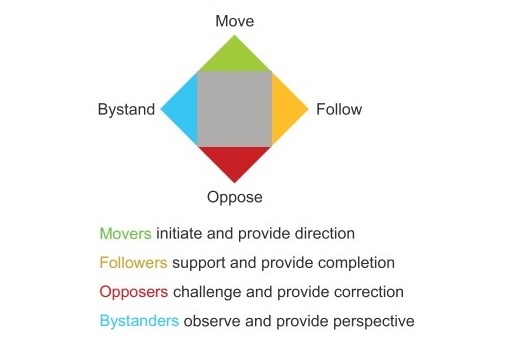2.2.1 Kantor’s four-player model
There are patterns in conversations that affect their outcome (Kantor, 2012a). Paying attention to these, and knowing how to intervene to make conversations productive, is key to collective leadership. Kantor’s theory of structural dynamics identifies important elements of communication and the different practices that help generate ‘dynamic discourse’ (Kantor Institute, 2017).
Kantor argues that in all interactions between people there are only four possible ‘speech acts’: move, follow, oppose and bystand (Kantor et al., 2014). In effective communication, all of these acts need to be present, as each plays a different role:
‘Stuck’ interactions tend to display only one or two of these acts, rather than having a balance. The most common of these acts is ‘move’ and you can probably recognise this tendency from your own experiences. People stop engaging in open dialogue and instead focus on expressing opinion. Some people try to dominate conversations, or feel that they need to behave in this way to gain respect or credit. Sometimes meetings can deteriorate because everyone is fighting for attention by moving, rather than working together to generate collective insight.
One important leadership task can therefore be to encourage others to follow, oppose or bystand in order to nurture the energy of the conversation.
Conversations can become stuck in too much following, opposing or bystanding, however. If a conversation is dominated by following, it loses critical bite. In the case of opposing, a conversation can become too negative. If a conversation is dominated by bystanding, it loses sight of the purpose of the conversation, getting stuck in commentary on process.
The key for nurturing conversations is therefore to seek a balance of roles. If team members learn to recognise speech acts in a conversation, to ‘read the room’, and to understand the preferred roles of their colleagues, then they can ‘diagnose’ conversations, and correct imbalances. Kantor et al. (2014) refer to this ability as ‘communicative competency’.
Now, it’s time for you to think about how you could use the model.

